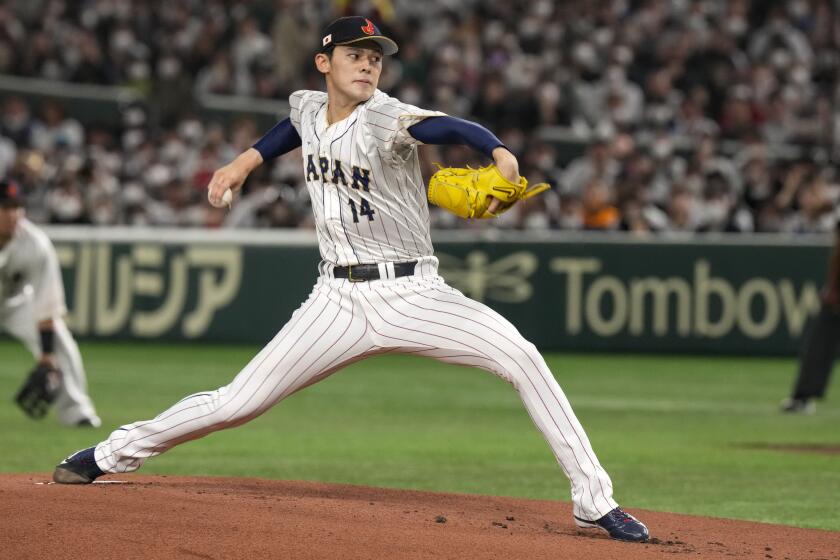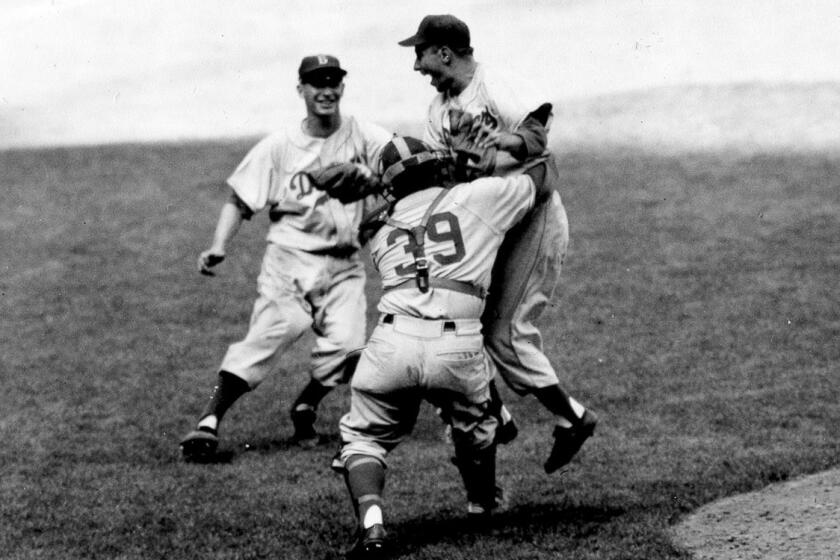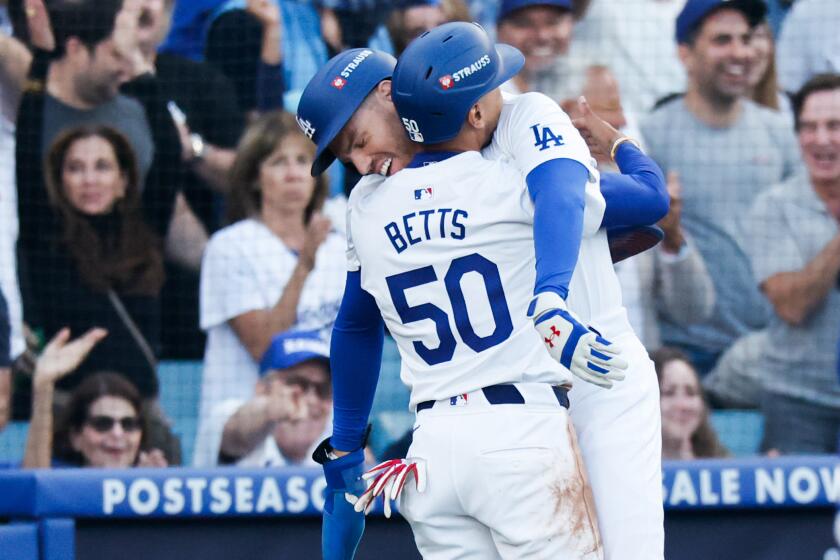Dodgers have become penny-wise on player development
The menu included steak and fancy fish, but the man most responsible for sustaining the Dodgers’ success ordered a tuna sandwich.
“I grew up poor,” Logan White said. “I’m a pretty frugal person. I don’t like to have ridiculous waste. I was raised to be wise and prudent and not overpay.”
This makes White the perfect person to run the Dodgers’ scouting operations at a crucial juncture in club history. The no-longer-young core is rapidly approaching free agency, and how the Dodgers manage the inevitable roster renovation might well determine whether the franchise preserves the anticipation of a World Series or reverts to the mediocrity of the post-Kirk Gibson era.
The Dodgers no longer spend big bucks on free agents, so White and his staff must sign enough prospects to replenish the major league roster and provide General Manager Ned Colletti with a stash of trade chips as well. Yet the Dodgers also have stopped spending big bucks in the draft and abroad, effectively restricting White from signing some premium amateur talent.
If we jump to the logical conclusion — that the Dodgers are undermining their ability to contend for the World Series in coming years — White warns us to look before we leap.
“I don’t want people to think that because we’re not spending the money the way some teams are, we’re not getting players,” he said. “That is so far from the truth.”
Baseball America, the bible of player development, ranked the Dodgers among the top 10 in minor league talent from 2004 to 2008, then dropped that ranking to 23rd last year and 24th this year.
That happens, of course, when the likes of Matt Kemp and Clayton Kershaw graduate to the major leagues. That also happens, though, when the Dodgers spend the least of any major league club in the last two drafts, and when the Dodgers do not account for any of the 115 international signings over $100,000 in 2008.
“There’s a difference between cheap and wise,” White said. “I like to think we’re wise.”
Of the 144 non-drafted international players currently on major league rosters, the Dodgers say they signed 11, more than any club but the New York Yankees. White says that since he joined the Dodgers in 2002, they have produced more major leaguers than all but two other clubs.
In 2002, White struck gold with James Loney, Jonathan Broxton and Russell Martin. In 2003, he got Kemp, Chad Billingsley, and Andy LaRoche, who was included in the trade that brought Manny Ramirez to Los Angeles. Colletti turned Milton Bradley into Andre Ethier in 2005, White nabbed Kershaw in 2006, and there’s your core.
The future does not appear quite so bright. The Dodgers don’t put too much stock into how much money they spent in the draft, since the teams with the worst records draft the highest and, generally, pay the most.
“For Pittsburgh and Kansas City and all those teams that have outspent us, what do their fans have to be happy about?” White said. “They’re still going to have 18 or 19 losing seasons in a row. We’re not.”
Yet the New York Yankees and Boston Red Sox spend freely in the draft, stocking up by selecting players whose demands for high bonuses have scared off poorer teams and aggravated Commissioner Bud Selig. The Dodgers, with rare exceptions, refuse to pay above the bonus recommended by the commissioner’s office.
“We’ve tried to be a team player within MLB and address the unreasonable bonuses,” White said, “and stay within what we feel is fair money for a pick.
“Has that had an impact? Sure. Do I think we can draft and sign quality players? Absolutely. I don’t have such a limited amount of money that we’re not going to be able to produce players.”
The Dodgers can compensate by shining beyond the first round, White said, noting that Kemp was selected in the sixth round and Martin in the 17th. That challenge is stiffer today, according to Baseball America editor in chief John Manuel, because White loaded up on high school players at a time conventional wisdom dictated otherwise.
“It was easier to find diamonds in the rough then,” Manuel said. “The industry was in the grip of Moneyball, and a lot of teams were drafting nothing but college guys.”
Conventional wisdom today dictates spending freely in Latin America, where players are not subject to the draft and can sign with the highest bidder, as soon as age 16.
The Dodgers signed Adrian Beltre for $17,000 and Joel Guzman for $2.25 million, so you never know. But, as the bidding for elite prospects has climbed past $3 million and $4 million, the Dodgers aren’t playing.
White says that is his call, that his studies show the risk is far greater than the reward at those prices.
“It may look good for the moment to say we got a player for $3 million and the Yankees were offering $2.5 million,” White said, “but when you look four and five years down the road, it wasn’t a wise decision.”
As an alternative to spending on major league free agents, small-market clubs such as the San Diego Padres and Oakland Athletics have invested heavily in Latin America.
“I think of the international market as a feeding frenzy,” White said. “It’s like a bunch of sharks. You just throw some food in the water and they all go crazy.
“People will go back and look at the millions of dollars baseball teams spent in Latin America the last five years on guys who are not good enough to get to the major leagues and haven’t even become good enough to become a trade piece.”
White prefers not to sign 16-year-olds. He would rather assess their physical and mental development after another year or two, even at the risk of losing an elite Dominican prospect or two.
The Dodgers signed pitcher Ramon Troncoso at 19 and top prospects in catcher Carlos Santana — since traded for Casey Blake — and third baseman Pedro Baez at 18. Rubby de la Rosa, also signed from the Dominican Republic at 18, hit 98 mph in his Midwest League debut on Friday.
Manuel, the Baseball America editor, said the clubs that do the best in Latin America tend to accept the inefficiencies in the system. He also said the Dodgers, so proud of their heritage in international baseball, are squandering a competitive edge.
“The Dodgers brand name, internationally, should be the best,” he said. “They’re no longer a leader. They used to be so far out in front of other organizations. That’s an advantage they have not maintained.”
It is not that the Dodgers cannot contend without pouring money into major league free agents, draft picks and international signings. However, given the prices they charge for tickets and parking, and given that they led the major leagues in attendance last season, it is unconscionable that ownership won’t pour money into at least one of those areas, to leverage the advantage of playing in Los Angeles into the best possible chance to dominate the National League West.
On that score, White sounds almost defiant.
“We’ve made some mistakes on our own, but it’s not been for lack of money. Since I’ve been here, I’ve always had the amount of money I need to spend,” he said. “If I spent another $10 million, could I produce any more? It’s near impossible. It’s certainly not a money thing.”
He had better be right, for Frank McCourt’s sake.
Clicking on Green Links will take you to a third-party e-commerce site. These sites are not operated by the Los Angeles Times. The Times Editorial staff is not involved in any way with Green Links or with these third-party sites.
More to Read
Are you a true-blue fan?
Get our Dodgers Dugout newsletter for insights, news and much more.
You may occasionally receive promotional content from the Los Angeles Times.











